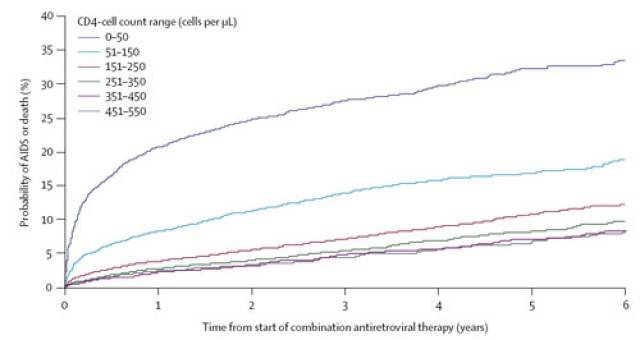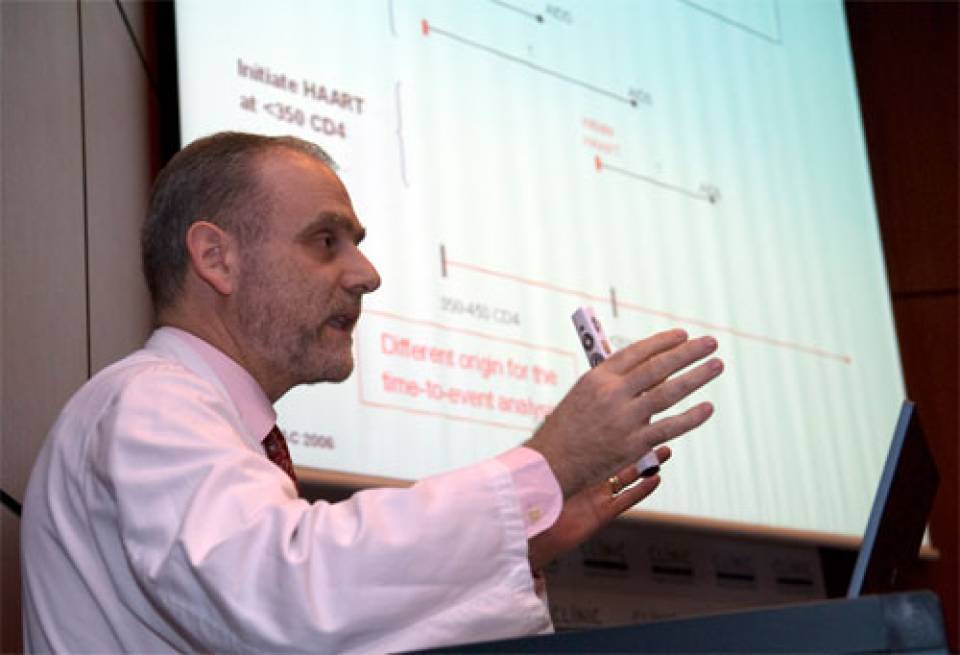The best moment to instate antiretroviral treatment has been the subject of debate for some time. The immune system’s CD4 cell count, which falls as HIV infection progresses, is one of the main tools for establishing a guideline cutoff point. Current clinical guides recommend waiting for the CD4 count to fall below 350 cells per milliliter (µL) in asymptomatic patients. Although it was suspected that initiating treatment earlier could improve outcome, this recommendation was maintained due to the side effects associated with the drugs, making correct administration of the treatment difficult. With new families of drugs available and new, less toxic combinations, it is now possible to consider instating treatment earlier without unduly affecting the patient’s quality of life.
The study published in The Lancet, in the framework of the Antiretroviral Therapy Cohort Collaboration, includes information from 15 international cohorts. Data were obtained from 21,247 patients who were followed up during the period prior to instatement of combined antiretroviral therapy and 24,444 patients who were followed up from the beginning of treatment. Waiting to administer the combined therapy until CD4 levels had fallen to between 251 and 350 cells/µL was associated with a 28% higher rate of development of AIDS and death than beginning treatment when levels were between 351 and 450 cells/µL. The adverse effects of delaying therapy were directly linked to the drop in the CD4 count. Waiting to treat until the CD4 count was below these levels was also associated with a higher mortality rate (13%), though the effect on mortality was smaller than the combined effect on developing AIDS and death.

The conclusion of the study is that the lowest level for initiating antiretroviral therapy is 350 cells/µL. This will soon be indicated in the clinical guides and in clinical practice. The Gesida/National AIDS Plan guides are already being drawn up and will include the recommendation to initiated treatment before the CD4 count falls below 350 cell/µL. The new recommended figure will probably be between 350 and 500 cells/µL. The international clinical guides (both European and American), which will not be updated for some months, and the SMART clinical trial also suspected that antiretroviral therapy should begin before the CD4 count falls to 350 cells/µL. Furthermore, the journal New England Journal of Medicine (NEJM) published identical results this month, obtained by a North American study that also involved many cohorts (NA-ACCORD). The findings of these studies will be key to helping doctors throughout the world to decide on the best time to begin antiretroviral treatment.
The Catalan and Balearic cohort PISCIS (Project for the Computerization and Clinical Epidemiological Monitoring of HIV Infection and AIDS) was created in 1998 and is currently monitoring more than 10,000 patients. Nine Catalan hospitals are taking part: Hospital Clínic, Barcelona; Hospital Universitari Germans Trias i Pujol; Hospital de Bellvitge; Corporació Parc Taulí de Sabadell; Hospital de Mataró; Hospital General de Vic; Hospital de Palamós; Hospital General de l’Hospitalet; and Hospital Alt Penedès de Vilafranca. A Balearic hospital, the Son Dureta hospital in Mallorca, is also taking part and the CEEISCAT is acting as the coordinating center.
The PISCIS project, which is funded by the Department of Health and the FIPSE, has already provided important local responses to questions such as survival of infected patients, effectiveness of antiretroviral therapies and the best time to begin treatment. The study published in The Lancet confirms the findings that PISCIS had already published based on Catalan and Balearic data in the journal JAIDS (J Acquir Immune Defic Syndr. 2008; 47(2):212-20), suggesting that the minimum CD4 count for beginning treatment is at the threshold of 350 cells/µL. The Department of Health aims to potentiate this project so that it covers the largest possible number of Catalan hospitals and serves not only for clinical-epidemiologic research but also for the planning and assessment of services relating to this disease and as a source of complementary information for monitoring important aspects such as delayed diagnosis, resistance and new mortality patterns in these patients.
For more information:
IDIBAPS - Hospital Clínic, Barcelona - Corporate Communication Department
Àlex Argemí (aargemi@clinic.ub.es)
Marc de Semir, Director (mdesemir@clinic.ub.es)
Tel.: 93 227 57 00
www.idibaps.ub.edu
http://blog.hospitalclinic.org
CEEISCAT - Catalan Institute of Oncology (ICO)
Communication Department
Johanna Cáceres (jcaceres@iconcologia.net)
Tel.: 93 260 72 97

